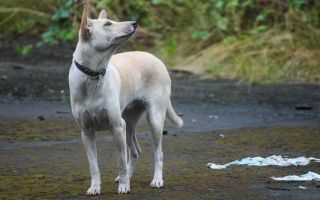Echinococcus (Echinococcus granulosus) is a small cestode 2-11 mm long.
The disease caused by these worms, echinococcosis, is described in detail in the article “ Echinococcosis - symptoms, diagnosis, treatment .”
Description
The body of the worm has a pear-shaped scolex, equipped with 4 suckers and a proboscis with 2 hook rims. Behind the neck there is a short strobila, which usually consists of three proglotids. The first segment is immature, the second is hermaphroditic, the third is mature.
In the mature segment there is a uterus with lateral projections, which contains 400-800 fertilized eggs with six-hooked oncospheres. Their diameter is 30-36 microns.
Finna (larvocyst, hydatid) is a single-chamber bladder filled with liquid, ranging in size from a few millimeters to the size of a newborn baby’s head. The Finnish wall has two shells:
- outer (cuticular, layered) and
- internal (embryo, germinal).
The outer layered shell consists of concentrically located plates, the chemical composition of which is close to hyaline and chitin.
The germinal membrane has three zones:
- cambial (parietal);
- middle, containing calcareous bodies;
- internal - zone of brood capsules, which contain protoscolexes with a proboscis and two rows of hooks, 4 suckers.
Inside the fins, secondary (daughter) larvocysts are often formed, and within them - tertiary (grandchildren) larvocysts, in which brood capsules and scolex also develop.
Around the echinococcal bladder, as a result of chronic inflammation, a connective tissue capsule is formed from the host tissue. Between it and the cuticular membrane there is a narrow space filled with polymorphic cellular infiltrate.
The fluid of the blisters is a secretion product of the germinal membrane and contains the necessary substances for the life of the parasite and metabolic products. The lifespan of larvocyst is several years.
Types of Echinococcus
Four species of the genus Echinococcus have been described:
- Echinococcus granulosus,
- Echinococcus multilocularis (synonym - Alveococcus multilocularis),
- Echinococcus vogeli,
- Echinococcus oligarthus.
Within Echinococcus granulosus, the causative agent of unilocular echinococcosis, two intraspecific variants are distinguished:
- European - Eg granulosus and
- northern - Eg canadensis.
Alveococcus multilocularis is the causative agent of an independent disease - alveococcosis (multilocular echinococcosis).
Echinococcus vogeli and Echinococcus oligarthus are the causative agents of polycystic echinococcosis, which is common in Central and South America.
Life cycle
The development of echinococcal tapeworm involves a change of two hosts.
The definitive hosts are dogs and all representatives of the canine family (wolves, jackals, hyenas, etc.). Echinococcus lives in the final host for 5-6 months. New segments constantly bud from the neck of the cestode, and the posterior (mature) proglotids break away from the strobila and exit into the external environment either with feces or actively crawling out through the anus. Crawling over the owner's body, they contaminate the animal's fur with eggs released from the uterus.
The eggs enter the body of the intermediate host (a wide range of mammals, including humans) through the mouth.
In the small intestine, the oncosphere emerges from the eggs and, with the help of hooks, penetrates the blood vessels of the intestine and then through the portal vein into the liver, where most of them are retained and form finnosis blisters. Some of the oncospheres bypass the liver barrier and enter the heart, from where they penetrate through the vessels of the pulmonary circulation into the lungs, where they are retained.
Oncospheres can be carried with the blood into any human organ (brain, spleen, kidneys, bones), where they form a larvocyst.
The definitive hosts become infected by eating the organs of the intermediate host, which contain the echinococcal vesicle. In the small intestine of the final host, the membranes of the bladder are destroyed, and the protoscoles are attached to the mucous membrane. The growth of segments begins from the neck, and after 3 months mature cestodes are formed. The echinococcal bladder contains many protoscolexes and brood chambers, so a very large number of parasites (tens of thousands) develop in the intestines of canines.







